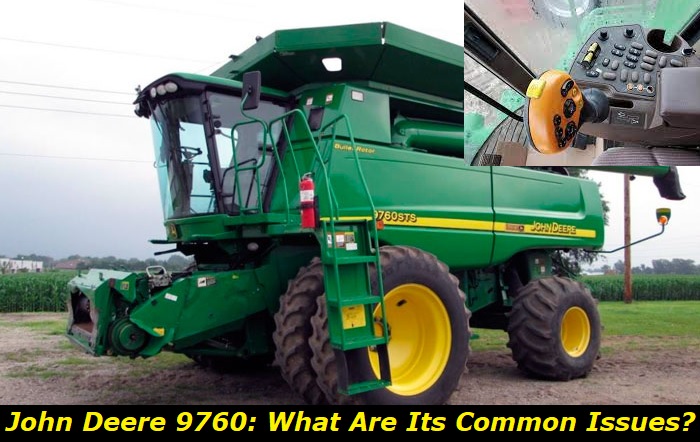John Deere 9760: Problems, Durability, Repairs
The John Deere 9760 is seen by many as a reliable, practical, and comfortable combine harvester by many operators. As such, they definitely consider it to be a bang for their buck.
So, if you're looking for a combine harvester that will give you good value for your money, this is one that you should definitely include in your checklist. However, before doing such, there are certain issues that you should be aware of, which tend to pop up within the life of the machine, especially when it is already subjected to a significant amount of usage.

Durability of the John Deere 9760
The durability of the John Deere 9760 is not set in stone because of the varying factors that may influence its quick wear like rigorous labor, skipping regular maintenance, exposure to harsh environmental conditions, and others related to its irresponsible operation. However, if its regular cleaning as well as scheduled filter and parts changes are followed, one could stretch its longevity by over 4,000 operating hours.
Most Common Problem Found in the John Deere 9760
There are many problems that can pop up in a harvester depending on a lot of factors involved. In the case of the John Deere 9760, these are the most common issues that you should definitely keep a lookout for:
1. Engine Bogging
One of the most common problems found in the John Deere 9760 is engine bogging issues that mostly result in stalling. This can happen when the engine isn't receiving enough fuel to run properly, resulting in a lack of power and reduced productivity.
Diagnosing the root cause of this problem can be tricky because there are many potential causes. However, with proper diagnosis and troubleshooting techniques, you should be able to find the source of your engine bogging issues.
One way to diagnose engine bogging is to use visual inspection and manual checks. Look for any signs of fuel leaks or clogs along the fuel lines from the tank to the engine. Check for any loose connections or defective parts that could be causing a disruption in fuel flow.
If everything looks good up until the injection pump then it's time to move on to using specialized tools like a vacuum gauge, fuel pressure gauge, or scan tool.
Using these tools can help you identify specific areas where the fuel is not reaching its destination. If the cause of your engine bogging is a fuel line leak or clog, then you may need to replace the fuel lines, injectors, and any other components that are associated with them.
It's also important to check for any faulty sensors or loose connectors that could be causing issues with the fuel delivery system. Additionally, if your engine is running lean from lack of fuel flow, then it might be time to consider replacing your fuel pump as well.
By following these simple steps and consulting your service manual before attempting any repairs on your John Deere 9760, you should be able to identify the root cause of your engine bogging issues and get back to full productivity in no time.
Keep in mind that any repairs you attempt should be done by a qualified technician, as improper repair can lead to more problems down the line. With proper diagnosis and maintenance, you can keep your John Deere 9760 running smoothly for years to come.
Once you have identified the source of the engine bogging problem and replaced any necessary parts, it's important to test out your repairs before putting the vehicle back into service. This will allow you to ensure that all of your repairs have been successful and that there are no further issues with power or fuel delivery before getting back on the road.
Taking this extra step will help you to avoid any further problems and ensure that your John Deere 9760 is running as efficiently as possible.
2. Hydraulic System Failure
As with any equipment that has been subjected to heavy use or lacking regular maintenance, hydraulic system failure may happen at some point within the life of the John Deere 9760. This can have a significant impact on the productivity of the machine, and in some cases may mean that it needs to be taken out of service entirely until repairs are made.
Common symptoms of hydraulic system failure in the John Deere 9760 include drops in pressure when engaging hydraulics, slower than usual response times for the hydraulics, or leaks due to damaged components.
Diagnosing the cause of a hydraulic system failure with this model requires careful examination. Manual checks should be conducted first, looking for any visible signs of damage, leakage, or blockage. If necessary, tools such as multimeters or oscilloscopes may be used to further investigate issues with electrical components within the system.
Through these processes, it is often possible to determine which components are responsible for the failure.
Once the cause of any hydraulic system failure in a John Deere 9760 has been determined, it is relatively straightforward to make repairs. Depending on the fault, this may involve replacing hoses and other components that have become damaged or need replacing due to wear.
In some instances, it may also be necessary to replace entire pumps within the system if they have malfunctioned. It is important for owners of this model to ensure that regular maintenance is conducted so as to reduce the likelihood of unexpected or prolonged downtime due to a hydraulic system failure. With proper care and attention, these issues can be avoided or minimized.
3. Hard Starts
Having hard starts in a John Deere 9760 harvester can have serious effects on productivity as it would be difficult to get the combine harvester moving and running. There are several possible causes of this issue, including low levels of fuel or oil, incorrect timing settings, or faulty parts such as the spark plugs or ignition coil.
To assess the cause of the problem, users should first manually check for any issues with these components. The spark plugs should be checked to ensure they are clean and properly gapped; if they're not working correctly, then replacing them can help resolve the issue.
Similarly, the ignition coil should be inspected to make sure it's providing enough voltage to power the engine. Additionally, sensors such as those for fuel, oil, and temperature should be checked to make sure they're providing accurate readings.
Tools such as a multimeter can also be used to measure voltage in order to determine if there is an issue with the ignition coil or spark plugs. Additionally, using a compression tester can help diagnose issues related to low compressions such as worn piston rings or head gasket damage. Finally, taking apart components and visually inspecting them for any signs of wear or damage can indicate whether they need replacing.
Oftentimes, hard starts on the John Deere 9760 can be resolved by replacing faulty parts such as spark plugs or ignition coils. If these components are not working properly, it will prevent the engine from getting enough power to start up and run properly.
Additionally, replacing any worn or damaged parts such as piston rings or head gaskets can help improve the engine's performance and reduce hard starts.
It is important to evaluate the cause of a hard start in the John Deere 9760 before attempting to repair it. Manual checks, using tools, and visual inspections can all be useful for diagnosing the issue and helping determine what parts may need replacing in order to resolve it.
With proper diagnosis and maintenance, users should experience fewer issues with hard starts on their John Deere 9760 machines.
4. Electrical Issues
Electrical issues in a John Deere 9760 combine harvester can present serious problems for productivity. The most common causes of these electrical issues tend to be related to the wiring, starter motor, and alternator. Handling any of these components incorrectly can lead to short circuits or corrosion that can damage the electronic control board, leading to further complications.
When diagnosing an issue with the John Deere 9760's electrical system, it is important to properly identify the cause. Diagnosis should begin by noting any symptoms such as dim lights, unresponsive controls, or dead batteries that could indicate a malfunctioning component. Manual checks such as looking at switches, wires, and connections as well as checking voltage levels with tools like multimeters may also provide clues about potential problems.
Once the source of the issue has been identified, a solution can be implemented. Depending on the problem, this could involve replacing worn-out parts such as wiring, starter, and alternator, or even an entire control board. In some cases, more drastic measures may be necessary.
For example, if corrosion is found in the starter motor it may need to be replaced entirely. No matter what the solution may be, ensuring that all connections are secure and running test cycles before putting the machine back into operation can save time and money in the long run.
Overall, electrical issues in the John Deere 9760 are a common issue that can impact productivity and need to be addressed promptly. With proper diagnosis and the right solution, however, it is possible to quickly restore optimum performance for this harvester. By following the steps above, anyone should be able to get their John Deere 9760 back on track with minimal effort.
Conclusion
With proper care, you can get the most out of the John Deere 9760. Just be sure to keep track of its regular cleaning and maintenance schedules to ensure its long-term productivity and your convenience in using it.

Add comment